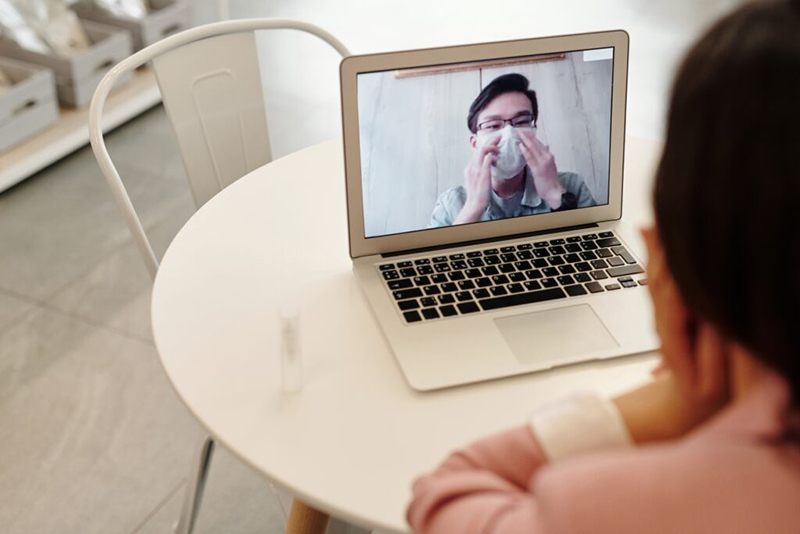
Jul 14, 2020 | BillFlash, NexTrust, Partner
The SIX KEYS to sustaining your practice through the COVID-19 pandemic are online payments, Telehealth, automation tools, cyber protection, financial aid, and a good patient experience.
When Coronavirus first started to impact medical practices across the country, providers quickly put temporary solutions in place to ensure they were still able to see patients safely. As the pandemic endured, some of these “temporary” solutions became a “normal” part of doing business. While we can’t predict exactly how COVID-19 will affect us in the future, one thing is becoming clearer every day: Some of the changes that have been made in the past few months will shape how healthcare is managed after the global health crisis is over.
So, it’s time to start thinking long-term with your COVID-19 strategy. Here are six ‘keys’ for sustaining your practice right now that will continue to be important after the pandemic is over.
1. ONLINE PAYMENTS
Most businesses already process a good amount of their payments online (including EZClaim), but healthcare has been slow to adapt in this area. Practices no longer have the luxury of taking their time adopting digital payment options. It’s time to give patients what they’ve been wanting for years: the ability to pay their bills online.
Because the pandemic is still with us, contactless payments have surged. No-touch payments are an easy way to reduce the spread of germs, and most people already have the tools they need to complete these types of payments: phones, computers, and credit cards.
Online payments are encouraged even when you’re meeting patients in the office. EZClaim customers can easily facilitate this with LinkPay. The process is easy and can be done once an appointment is made.
Here’s LinkPay in three simple steps:
1) Create a customized payment link with the required amount
2) Email or text the link to the patient before their visit
3) Patient pays the required amount, which is immediately confirmed and processed
COVID-19 demanded contactless payments for safety, but now patients now expect them for convenience. Medical practices will need online payments if they are to stay relevant in the future.
2. TELEHEALTH
Telehealth threw providers a lifeline when patients stopped coming into the office. The government acted quickly to relax Telehealth reimbursement policies so providers would be paid just as much for a Telehealth visit as they would for an in-office visit.
Congress is hoping to make these changes permanent. Whether they succeed or not, plan on keeping Telehealth as an option for your patients. Because Telehealth is not just useful during a pandemic, it’s great during normal life, too. Not all visits require an in-person encounter, and patients of all ages can benefit from the convenience of not having to physically leave their homes to get the medical care they need.
Patients have become used to having Telehealth as an option. Keeping it as an option going forward will set you apart from other practices.
3. AUTOMATION TOOLS
Chances are you are working with fewer people than normal. So, with fewer people to handle your billing and payments, your best option is to automate whatever you can.
This could mean setting up AutoPay for patients you see regularly, so they don’t have to manually pay their bill every time. It could also mean setting up a payment plan, in which a fixed amount will be paid automatically every month until the balance is paid off. It could also mean outsourcing your collections.
Automation doesn’t mean you lose control. Rather, it gives your staff more time to manage other essential operations. EZClaim customers have all of these automation options available to them through BillFlash.
4. CYBER PROTECTION
With digital tools becoming more prevalent, it is more important than ever to make sure your systems are protected. Hackers are out in full force right now, so it is imperative that you have proper malware and anti-virus software in place to protect your practice, your patients, and your employees. Do your homework on the tech companies you work with, too. Protecting your practice and your patients should be a top priority!
Of course, your staff will need to be up-to-date on HIPAA protocols, as well. Make sure you are doing everything you need to protect patient privacy online as well as offline.
5. FINANCIAL AID
Some practices are struggling financially and may need government aid to get them through the current crisis. Keep an eye on government funds that are available and stay informed on their different requirements.
If you haven’t already, consider applying for a line of credit. This is a standard operating procedure—even during normal times—and can help protect you from further financial disruptions in the future. No one knows how long this pandemic will last, so having a line of credit to fall back on during the coming months and years could be a game-changer for your practice.
6. A GOOD PATIENT EXPERIENCE
Above all, you need happy patients. That is true whether we are in a recession or not. Happy patients are more likely to pay their bills, more likely to return for future care, and more likely to recommend you to family and friends.
So, as you make some of the changes you made during the pandemic permanent, make sure you are still doing the little things to ensure a positive patient experience. These include:
• Keep wait times short
• Maintain eye contact during visits to assure patients that you care
• Be transparent about payment expectations and insurance, as well as what you’re doing to keep patients and staff safe
• Allow patients to pay using their preferred payment method
• Offer payment plans in lieu of paying large bills in one lump sum
A positive patient experience will be key in bringing your patients back to the office as the global health crisis continues.
NexTrust from BillFlash offers a variety of innovative billing and payments solutions for EZClaim customers. Visit billflash.com or e-mail them at Sales@BillFlash.com to learn more about how you can get paid more, get paid faster, and ensure you have the online tools you need to thrive during the pandemic.
For details and features about EZClaim’s medical billing software, or the other partners they have integrated into their billing solution, visit their website.
[ Written by Kathy Scott, Marketing Manager at BillFlash and NexTrust, Inc. ]

Jun 10, 2020 | BillFlash, Electronic Billing, Medical Billing Software Blog, Partner
There are five things to consider as you reopen your medical office: Reevaluate your budget; Get your staff’s buy-in; How to actively bring patients back into the office; Continuing to use Telemedicine and other online tools, and be flexible.
As the curve flattens and restrictions around the country loosen up, medical practices are slowly reopening their doors for non-essential services. But reopening doesn’t mean business will resume as usual. Every industry is making changes as we navigate a “new normal.”
Many of those changes center on social distancing guidelines, but there are other matters to consider as well. Here are some details about the strategies to keep in mind as you reopen.
Reevaluate Your Budget
Government restrictions may be lifting, but medical practices are not going to bounce back immediately. Any financial goals you had in place for 2020 likely won’t be met this year.
Some budgetary adjustments will be necessary. Here are just a few ideas:
- Check in with vendors, landlords, and creditors to discuss any accommodations they may have for cash-flow disruptions
- Consider delaying payment of bonuses and other discretionary payments
- Seek aid from government economic relief packages and loans for small businesses and front-line workers. Stay informed on what your options are, as changes are ongoing.
This goes without saying, but make sure you’re up to date on patient billing and payments, too, including telemedicine visits. If you have patients who need extra time to pay their bills, EZClaim customers can set up a payment plan for them using BillFlash PlanPay.
Get Your Staff’s Buy-In
Before you start bringing patients back in, your entire medical staff needs to understand your new policies and be on board with enforcing them. They need to be reassured that their safety is a top priority, as well.
It’s been a difficult few months for front-line healthcare workers and will continue to be stressful in the months going forward. Do what you can to acknowledge their hard work and dedication.
Actively Bring Patients Back to the Office
Some people are eager to get out of their homes and into public spaces again, while others plan to shelter in place a while longer. Either way, your patients aren’t going to return in droves. Many are less comfortable going back to a doctor’s office, so be proactive about making your patients feel safe enough to return.
Americans have become experts on how viruses spread over the past few months, so anything you’re doing to clean and sanitize your office should be visible. Affixing physical distancing floor markers, procuring enough PPE for your staff, and installing hand sanitizer stations is a good start. Show your patients what you’re doing to protect them; simply telling them what you’re doing when they aren’t around won’t be enough.
As you communicate your new policies to patients, be aware that they may be feeling overwhelmed. Be transparent and connect with them on a personal level. Don’t be afraid to show your human side; otherwise, your office will be just another place with a long list of rules to follow.
Keep Using Telemedicine and Other Online Tools
The technology that got you through stay-at-home orders can continue to support you long term. Telehealth isn’t going away. Plus, patients will still want contactless payment options.
Evaluate what has worked over the last few months and incorporate them as part of your new normal.
For example, you may want to have a plan in place regarding which patients get priority with Telehealth. At-risk individuals will still need to stay home as much as possible, so make sure Telehealth will still be an option for them.
Another tool that has been valuable during the pandemic is contactless payments. COVID-19 has changed the way people are paying—for the good. They want the option to pay their bills online, or directly from their mobile devices. Some patients will even consider switching providers if another practice offers them online payment options their current provider doesn’t have.
EZClaim easily accommodates a variety of payment preferences with its BillFlash integration, from online SelfPay to sending pre-visit charges for telemedicine visits (LinkPay). Sign up for a demo here. You can try BillFlash, at no cost, for 30 days.
Be Flexible
Local outbreaks may still happen. Many households have lost income. Patients have different preferences and needs regarding where an encounter happens and how they pay.
Things are still changing by the week. As much as we all want a new, consistent normal, we need to be prepared to continue to make adjustments as needed. Ultimately, it is your patients and your practice’s financial health that will benefit from your ability to adjust to the times.
BillFlash, a fully integrated component and trusted partner of EZClaim, offers a variety of revenue cycle management services that have served EZClaim customers well for many years, as well as through the COVID-19 pandemic. For more information or to see a demo, contact BillFlash at 435-940-9123, email them at GetPaid@BillFlash.com, or visit their website at BillFlash.com.
For detailed product features or general information about EZClaim, you can either schedule a one-on-one consultation with our sales team, view a recorded demo, or download a FREE 30-day trial right now.
For general information about EZClaim, visit our website at ezclaim.com/

May 12, 2020 | Electronic Billing, EZClaim Premier, Features
A recent medical billing webinar on Telehealth that EZclaim hosted is now available to review.
On April 30th, EZClaim hosted a Telehealth Updates Webinar for our clients with guest speaker Sandy Giangreco Brown – Director of Coding and Revenue Integrity Health Care at CliftonLarsonAllen, LLP
We had one of the largest viewing audiences 101 active attendees in the session. Sandy shared informative billing codes and direct links to update hands-on information for billers actively coding Telehealth sessions. For those of you who missed it, we have provided on our website the recorded session ezclaim.com/webinars and can provide the presentation slides too! Just send a request to sales@ezclaim.com
We continue to get views of this presentation and look forward to hosting more hot topics with the CLA Team.
With the onset of COVID-19 came a great opportunity for clinics and hospitals to offer Telehealth and Communication Technology Based (CTSB) services. The Centers of Medicare and Medicaid Services, or CMS, have provided many updates to the available services that can be provided and billed to the patients to help practices not only stay afloat financially but also and most importantly, to keep their staff safe and provide excellent care to their patients!
There were new guidelines released even after this webinar on 4/30/2020 (which can be found here – https://www.cms.gov/files/document/se20016.pdf, and now includes audio-only Telehealth for services such as psychotherapy, tobacco cessation and medical nutrition counseling as well as diabetes self-management training. CMS is also increasing the payments for the Audio Only services from $14-$41 nationally to $46-$110.
As of April 30, 2020, in order to bill Telehealth, RHCs are now required to bill the G2025–CG–95 from January 27, 2020, to June 30, 2020. Then from July 1, 2020, to the end of the PHE, they will be billing the G2025 with an optional 95 modifier, per CMS SE20016 Medicare Learning Network Transmittal.
FQHCs will need to report three (3) codes for their Telehealth Services:
- G0467 (or other appropriate FQHC specific payment code)
- 99214–95 (or other FQHC PPS Qualifying Payment Code)
- G2025–95
CLA is on the frontlines and closely monitoring and analyzing activities related to Telehealth and other virtual health regulations
CMS Telehealth fact sheet, Frequently Ask Questions:
As your practice adjusts to Telehealth going forward, EZclaim’s medical billing solution can help you simplify patient billing and help you get paid for Telehealth visits. (Our recent medical billing webinar on Telehealth may just help you better understand the current situation).
So, to help you investigate how EZclaim’s medical billing solution may work for you, either schedule a one-on-one consultation with our sales team or download a FREE TRIAL to check out the software yourself. For additional information right now, contact EZclaim’s sales team at 877.650.0904 or send an e-mail to sales@ezclaim.com.
[Contributed by Sandy Giangreco Brown – Director of Coding and Revenue Integrity Health Care, CliftonLarsenAllen LLP]

Apr 13, 2020 | Live Compliance, Medical Billing Software Blog, Partner
Since CMS HHS just updated their Telehealth regulations to adjust to the COVID-19 environment—including having a remote workforce—we wanted to provide a clear update to independent physicians and billers to advise them of the fast-moving changes of many regulations, and what to expect in the near future.
It is important to note that CMS has recently announced that new and established patients have availability to Telehealth, and HHS OIG is providing flexibility for healthcare providers to reduce or waive cost-sharing for Telehealth visits paid by federal healthcare programs. CMS is also expanding Telehealth services to people with medicare.
As a result, please see the below video from CMS which highlights the Medicare Coverage and Payment of Virtual Services and Telehealth.
In addition, we’ve included a few key questions and answers below. If you have further questions about Telehealth and your compliance, contact Jim Johnson with Live Compliance at Jim@LiveCompliance.com or (980) 999-1585.
1. Who can provide Telehealth services?
-
- Physicians
- Nurse Practitioners
- Physician assistants
- Nurse-midwives
- Certified nurse anesthetists
- Clinical psychologists
- Registered dietitians
- Nutrition professionals
2. What services can a medicare beneficiary receive through Telehealth?
-
- Evaluation and management visits (common office visits)
- Mental health counseling
- Preventive health screenings
- More than 80 additional services
3. What are the types of virtual services?
-
- Medicare Telehealth visits
- Virtual check-ins
- E-visits
- Telephone services
Live Compliance is an EZclaim premier partner for HIPAA compliance and is integrated into EZclaim’s billing solution.
If you have any further questions about Telehealth regulations and your compliance, e-mail Jim Johnson at Live Compliance at Jim@LiveCompliance.com, or phone him at (980) 999-1585.
[ Contribution by Jim Johnson with the Live Compliance ]

Apr 13, 2020 | Alpha II, Medical Billing Software Blog, Partner
One of our partners, Alpha II, is presenting a special webinar on COVID-19 billing changes on April 16, 2020, “COVID-19: Critical Coding and Regulatory Updates,” to provide the most up-to-date information on the coming changes to new procedures, diagnosis codes, telehealth updates, and changes to regulatory policies.
As guidelines for coding and billing of COVID-19 services are revised almost daily, rest assured Alpha II is working to implement these critical changes to regulations and coding guidance as quickly as possible by conducting near-daily promotions.
Here is a very brief summary of some of the updates we’ve implemented:
-
- Clarification of correct telehealth rendering POS and use of modifier -95
- Modification of diagnosis code edits for billing of COVID-19 symptoms from February 20 – March 31, 2020, and use of new diagnosis U07.1 for dates of service on or after April 1, 2020
- Addition of the new AMA CPT code 87635 effective March 13, 2020
- Addition of the new CMS CPT codes U0001 and U0002 retroactively effective February 4, 2020
- Modification for waiver of DME replacement requirements prior to March 1, 2020
- Modification for waiver of occurrence code 70 on SNF three-consecutive day stay validation prior to March 1, 2020
- Modification to LCD/NCD edits to relax rules related to respiratory-related devices and services
- Modification to Medicaid for the temporary suspension to prior authorization rules in PHE areas effective March 1, 2020
You can get all the latest COVID-19 specific updates here: https://www.alphaii.com/landing/covid19
Alpha II is an EZclaim partner that provides “Claim Scrubbing” for our medical billing software system. View our website for more details on this: https://ezclaim.com/partners/






